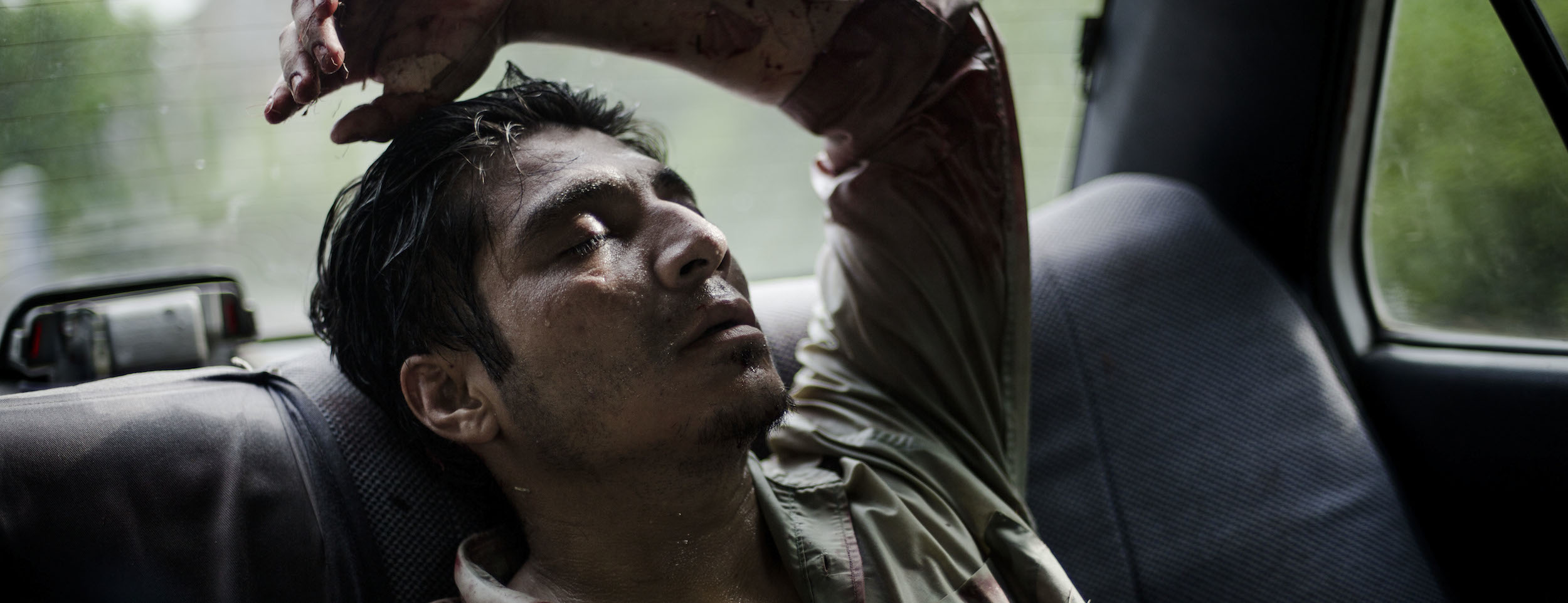“Son of a…!”
Óscar Martínez raced to the central jail. He’d just watched six of his sources get arrested. Earlier that day in June 2015, members of the 18th Street gang had shot a policeman in a nearby auto repair shop. The thirtieth officer killed that year in a bloody war between the gangs and the Salvadoran government, his death heated up the neighborhood. Police in the capital, San Salvador, started rounding up anyone who looked like a gang member.
In a bout of bad timing, Martínez’s sources had stepped off a bus just as a patrol car passed by. They fit the profile: male, young, dark-skinned, baggy-clothed. Although they came from a different part of the country, belonged to a rival gang, and had been nowhere near the auto repair shop that morning, they were cuffed and thrown in the back of a police truck.
Martínez got on the phone with his editor, José Luis Sanz. They talked over each other for a few seconds.
“Las Palmas is 18th Street territory—”
“Shit, do you think they’ll put them all in the same cell?”
“If these kids get killed, it’s our fault for putting them in danger.”
“And we lose our credibility with the gangs—”
They came up with a plan. Martínez would go to the jail to explain the situation to whomever was in charge. Sanz would call national police headquarters and human rights groups to try to get the kids released. They agreed to tell the truth: They were journalists from the digital newspaper El Faro, and they were concerned about their sources, who had been detained on their way to an interview. They would stress that these sources were from a part of the country controlled by the MS-13 gang; throwing them into cells with 18th Street members could be fatal.
Kill those sons of bitches, we don’t have space for them here,” a different male voice said. “We can’t fit any more in here. Kill them.
Martínez is 33, but could be mistaken for a college student. Short, often unshaven, he hangs at the back of press conferences, hunched over, scribbling in a tiny notebook. It’s easy to imagine him going unnoticed that afternoon at the police station, where he sat in a plastic chair in a corner for an hour and 42 minutes waiting to speak to a supervisor. He watched dozens of bleeding young men stagger into the station, where they were kicked in the ribs and pummeled into walls. He wrote down everything.
He listened as the policemen laughed and threatened to urinate on the prisoners. He listened to the police radio as nearby units called in to report their captures.
“Kill them. Kill those sons of bitches,” one female police officer said on the radio.
“Let’s not be rash,” said a male officer.
“Kill those sons of bitches, we don’t have space for them here,” a different male voice said. “We can’t fit any more in here. Kill them.”
“We can’t fit any more in here: kill them,” was the headline of the article El Faro published two days later, when most of the men had been released with bruises but no formal charges. It was a sober and straightforward account of what Martínez had seen and heard at the police station. It included the Inter-American Convention’s definition of torture, which reads in part: “Any act intentionally performed whereby physical or mental pain or suffering is inflicted on a person for purposes of criminal investigation, as a means of intimidation, as personal punishment, as a preventive measure, as a penalty, or for any other purpose.”
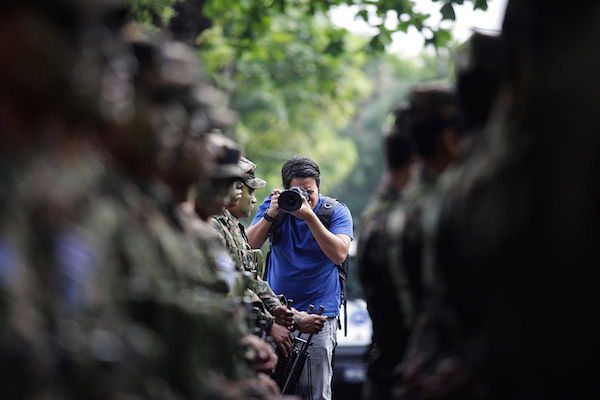
Photojournalist Fred Ramos documents the launch of a special army battalion to combat the gangs in April 2016. Though headlines refer to El Salvador as the “most dangerous peacetime country in the world,” the violence between the gangs and the government increasingly resembles a war. Photo by: Iliana Lemus
The backlash to Martínez’s story was swift and harsh. Most Salvadorans didn’t care about gang members’ suffering. They blamed the gangs for El Salvador’s status as the most violent country in the Western Hemisphere. Hundreds of comments on Facebook praised the police for “getting rid of the problem” and blasted El Faro for “defending” the so-called gang members.
“They’re a scourge that doesn’t deserve to live, it’s good that people applaud every rat that’s eliminated.”
“I agree, kill the gangsters, they’re a nuisance.”
“What side is El Faro on anyway?”
“It’s clear this is a terrorist, gang-controlled newspaper.”
Anonymous Twitter users threatened to “burn down” El Faro’s building and “massacre” its staff. Public posts called the journalists out by name and revealed their license plate numbers.
Sanz reported the threats to the attorney general’s office. A 42-year-old Spaniard from Valencia, he has been director of El Faro since 2014, and a reporter in El Salvador since 1999. He knew enough to take the threats seriously. He was especially concerned about Martínez and two other reporters who were in the middle of investigating the massacre of eight alleged gang members on a coffee farm that spring. The massacre had been committed by the police.
“Be careful,” Sanz told the reporters. “And hurry up.” As evidence of police abuse mounted, the story was increasingly important, but there were people who didn’t want it getting out. They were primed for retaliation after Martínez’s dispatch from the central jail. Later that month, just before El Faro published the story of the police massacre, Sanz decided to send Martínez and one of his co-writers out of the country for their own safety.
El Faro is in the business of making people uncomfortable. The news site was founded in 1998 by journalist Carlos Dada and businessman Jorge Simán, distant cousins with sharp tongues and unruly hair. They were sick of El Salvador’s media being controlled by a conservative oligarchy and censored by the military and the government. Dada, who is now 46, grew up in exile in Mexico during the 1980-1992 civil war between leftist guerrillas and El Salvador’s right-wing government. When he returned in 1996, he joined the first crop of college-educated Salvadoran journalists. They were eager for an independent press.
Simán and Dada envisioned deep-dive reporting presented in a format that would combine narrative and investigative journalism. “We loved the South American literary magazines, but the reality of our country didn’t lend itself to pure crónica,” says Dada, referring to the navel-gazing style of glossy journals like Etiqueta Negra from Peru, and Argentina’s Orsai. He found a different model in the clear-headed investigations of The New Yorker–which he brought back by the suitcase-load and translated into Spanish–and also in a handful of Latin American writers who straddled the two styles: Gabriel García Márquez, Elena Poniatowska, Martín Caparrós.
El Faro shunned hierarchy. Young reporters—poached from the Jesuit University and La Prensa Gráfica, the daily paper where Dada was an editor—participated in every aspect of production, from planning coverage to writing headlines. They cobbled together the stories on weekends in Dada’s living room. No one got paid.
El Faro is in the business of making people uncomfortable.
Despite their age—or perhaps because of it—the reporters were impervious to intimidation from political and economic power brokers. Over the years, El Faro has exposed corrupt presidents, conniving officials, negligent businessmen, and a drug-trafficking network so powerful that police provided bodyguards to four reporters for three months after the story was published. Dada’s profile of a military captain who participated in the 1980 assassination of beloved Salvadoran Archbishop Óscar Romero was so popular it broke the server.
At a time when most Salvadorans lacked running water—let alone electricity, computers or internet access—El Faro was the first publication in Latin America to exist only on the Web. This business model, initially a crutch, sealed its survival. Other pop-up publications in the postwar years were driven to the ground by printing costs. “We weren’t visionaries,” Simán says. “We were just broke.”
Eighteen years later, ElFaro.net has an annual budget of $850,000, a staff of 31, a two-story newsroom in a chic San Salvador neighborhood, more than 355,000 Facebook followers, 280,000 Twitter followers, and more than a million unique visitors per month. It has become one of Latin America’s most trusted news sites, and is probably the most decorated. This year alone, El Faro won the Gabriel García Márquez prize from the Foundation for New Ibero-American Journalism, and Óscar Martínez received both an International Press Freedom Award from the Committee to Protect Journalists and the Maria Moors Cabot Prize, which is administered by the Columbia Journalism School.
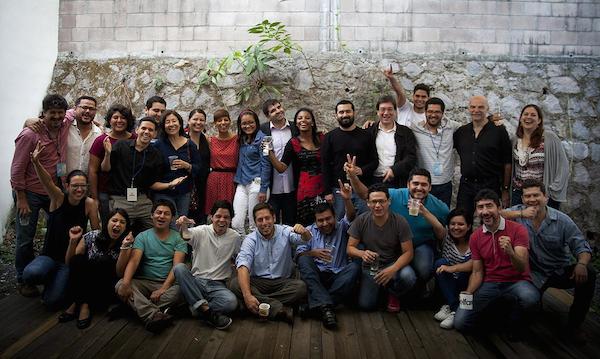
This year, El Faro was the first team to receive the Foundation for New Ibero-American Journalism’s Gabriel García Márquez prize, which had been previously awarded only to individuals. The newspaper is stubbornly egalitarian. Reporters even write their own headlines.
El Faro, which means “The Beacon,” is a crucial reference for foreign correspondents seeking to understand Central America and a model for Latin American digital start-ups like Plaza Pública in Guatemala and La Silla Vacía in Colombia. It is also a haven for journalists throughout the region. Scores of them flock to San Salvador each spring for El Faro’s Central American Journalism Forum, a frenzied week of workshops, speeches, and parties. Since it began in 2010, the event has attracted well-known guests like Seymour Hersh, Alma Guillermoprieto, and Jon Lee Anderson.
The site has also taken part in innovative global collaborations. It was the only news organization in the Northern Triangle—El Salvador, Honduras, and Guatemala—to participate in the Panama Papers project, and for the last seven months, reporters from El Faro have been working closely with The New York Times on an investigative piece about the finances of Salvadoran gangs. “Killers on a Shoestring,” which was published on Sunday, dispels the myth that El Salvador’s gangs are lucrative criminal enterprises, using El Faro’s exclusive access to gang sources and internal government documents to reveal that they are, at best, “mafias of the poor.”
We weren’t visionaries. We were just broke.
The effort was a pilot project for the Times—an attempt to expand and deepen international coverage by collaborating with a foreign publication. Three El Faro reporters—Efren Lemus and brothers Óscar and Carlos Martínez—did the groundwork, with Times investigative reporter Deborah Sontag supervising and coordinating with senior investigations editor Paul Fishleder. The Times paid El Faro nearly $15,000 for its work on the story.
El Faro seemed like a natural partner: fearless journalists, high standards, and an immense network of sources in a country where the Times doesn’t have a bureau. But the project turned out to be more logistically challenging than anyone expected, and raised questions about the site’s ability to play on an international stage.
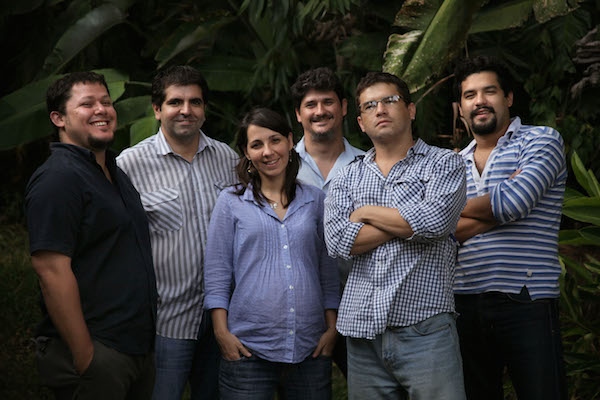
The original Sala Negra team. From left to right: Daniel Valencia, Roberto Valencia, Marcela Zamora (documentary filmmaker), José Luis Sanz, Carlos Martínez and Óscar Martínez. “We talked for hours after those early interviews with gang members,” Sanz said. “We looked for meaning in everything. We learned that we’d never deal with the top leader of a given zone. We realized everyone had a gun nearby, always. We saw that the clothes hanging everywhere in the prisons aren’t just there drying out — they’re there to block the guards’ view. These details helped us overcome our initial stupor. A journalist is called to explain things, and we have to know how to distinguish what’s important from what’s not.” Photo by Mauro Arias / El Faro (2012).
The El Faro reporters involved belong to a team called Sala Negra, or Black Salon, a Spotlight-like investigative unit focused on gang violence. The hassle of bilingual communication, primarily through Skype and email, was compounded by Sala Negra’s egalitarian work model, which meant that every conversation between reporters and editors had to be repeated several times. “It’s cool that there’s a constant dialogue going on among them,” Sontag told CJR, “but sometimes you can have so much process it slows down the product.”
By its own admission, El Faro didn’t start reporting soon enough, leaving big-picture questions unanswered and key sources untapped until late in the process. A massive government gang bust in late July threw the Salvadoran journalists off balance, confirming some of their reporting while casting doubt on other aspects of what they’d learned. The writing presented additional challenges. Unlike other news organizations with which the Times has collaborated—ProPublica and the Marshall Project, for example—El Faro wasn’t used to the inverted pyramid model of newspaper stories. Crónicas, even deeply-investigated ones, prioritize narrative. The Sala Negra reporters struggled to shorten scenes and find more straightforward ways to give readers context and background. “They’re two different narrative logics,” Sanz says.
That criticism is familiar to El Faro journalists. The site specializes in long, expansive oeuvres—numerous reporters described them as “bed sheets”—but often fails to provide the continuous, explanatory reporting necessary to understand a given issue. Paolo Luers, a rare bird in the Salvadoran media world (he has worked for El Faro, the conservative daily El Diario de Hoy, and the guerilla army’s propaganda machine), thinks El Faro owes it to readers to speed up its production cycle. “If you think the rest of the media doesn’t sufficiently lend itself to the creation of an independent, critical audience, you can’t just leave the privilege of informing people to the very publications you’re criticizing,” he says.
While El Faro was becoming the darling of Latin American journalism, Central America was devolving into the most violent region in the world. This is no coincidence. The news site covers a range of issues—politics, culture, corruption—but violence put it on the map. “The way El Faro tackled the underworld was a shock for the rest of us,” says Mexican journalist Marcela Turati. “They got close to criminals and brought back their stories.”
Starting in 2008, Óscar Martínez spent two years embedded with Central American migrants in Mexico, joined at different times by three photographers from the Spanish agency Ruido Photo and two documentary filmmakers. The journalists clambered onto cargo cars on the train known as “The Beast,” scrambled after “coyotes” in grueling terrain, and narrowly escaped confrontations with drug gangs who disapproved of their poking around.
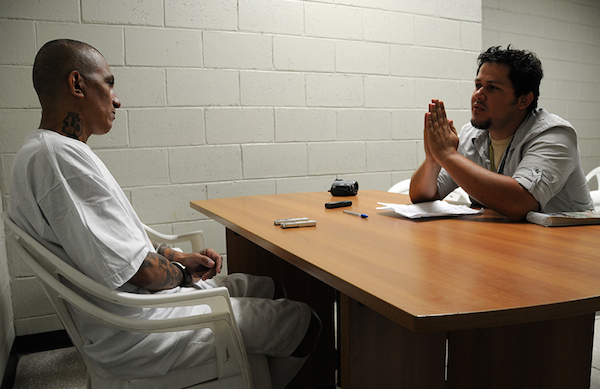
Sala Negra reporters sought out older gang members to explain how the gangs formed in Los Angeles and were transplanted to El Salvador. In this picture, Daniel Valencia interviews Viejo Lin, or Old Lin, the imprisoned leader of the 18th Street Gang. “He doesn’t like being called it…but in this world where grey hair is not in style, he’s venerably old,” Valencia writes. Photo by Pau Coll / Ruido Photo (2012).
The resulting series, “On the Road,” caught the attention of journalists throughout Latin America and beyond. Martínez’s subsequent book—titled The Beast in English—won critical acclaim in the US and Europe. “Óscar made that story come alive for people,” says New Yorker writer Francisco Goldman, who wrote the book’s introduction. “He’s partly responsible for the activism currently flourishing around the migrant issue.” Goldman compared Martínez to Vietnam War correspondent Michael Herr, noting that the two share a “precise blend of physical energy, curiosity, bravery, anger, and compassion” that allows them to see right to the core of something, and convey that deep truth to readers.
The way El Faro tackled the underworld was a shock for the rest of us. They got close to criminals and brought back their stories.
The series impressed program officers from Open Society Foundations, the philanthropic network started by George Soros that spends nearly $1 billion a year and funds independent media on five continents. Starting with an $85,000 grant for “On the Road” in 2008, OSF has been El Faro’s main source of revenue for the past eight years, giving the site a total of more than $2.5 million. Other donors include the Ford Foundation and the governments of Denmark and the Netherlands. In an effort to become more sustainable, El Faro is trying to wean itself off grant money, aiming for a model in which a third of its revenue comes from grants, a third from publicity, and a third directly from readers in the form of crowd-funding and subscriptions. Slowly, the site appears to be working its way toward self-sufficiency. In 2014, 80 percent of El Faro’s budget came from grants; this year, that proportion was 70 percent.
The stories Martínez heard from migrants convinced him of the need to better understand the Salvadoran gangs whose violence was driving people out. In 2011, El Faro created Sala Negra, whose half-dozen reporters peer-edit each other’s articles. For one of the unit’s first stories, “The Origin of Hate,” Sanz and Carlos Martínez traveled to Los Angeles to trace how criminal “cliques” formed in California in the 1980s. Another story documented their “viral expansion” in El Salvador in the 1990s and early 2000s after the US deported 4,000 gang members.
For the next several years, with nearly $1 million from Open Society, they played anthropologists. They asked hundreds of simple questions: Why did gangsters tattoo their faces? Why did teenage recruits accept being brutally beaten in order to become official members? Why did gangs extort poor businesses? The more time they spent in the slums, the more they understood that for a poor kid in a violent country, the only real question was this: Do you want to be a victim or a perpetrator?
“These are kids who the world is telling, ‘Eat shit. Eat the shit your father ate, eat the shit his father ate, and eat the shit his father ate before that,’” says Carlos Martínez. “Sooner or later, someone’s going to refuse.”
At first, readers were fascinated by El Faro’s gang coverage. But interest waned as violence took a greater toll on society. In 2010, 18th Street members set fire to a public bus on the outskirts of San Salvador, killing 17 passengers. Murders began to climb. By the time El Faro broke the story of a truce between the gangs and the government, Salvadorans had heard enough.
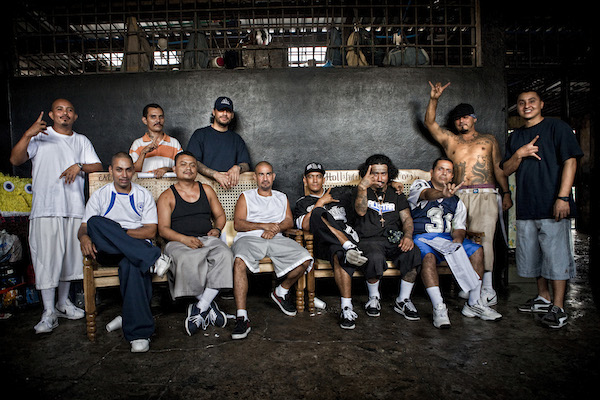
During the truce, imprisoned gang leaders would hold press conferences inside the prisons, like this one with the top leaders of the MS-13. It was later revealed that they also held dance parties with disco balls and strippers, to which members of the media were not invited. Photo by Pau Coll / Ruido (2012).
The February 2012 truce was orchestrated by the administration of President Mauricio Funes. In exchange for lowering the murder rate, top gang leaders from the MS-13 and Barrio 18 were transferred to minimum-security prisons, where guards turned a blind eye to cell phones, drugs, and other illicit activities. While most newspapers immediately attacked the government for “negotiating with terrorists,” El Faro withheld judgment. In a matter of weeks, El Salvador’s murder rate had dropped from 13 a day to about five.
Over the next year and a half, the trend continued, and El Faro published a series of articles showing how gang-dominated communities were transforming as a result of the truce. In one, by Carlos Martínez, bashful gang members and poufy-haired politicians come together to inaugurate a chicken farm where—in theory—gangsters will work incubating eggs rather than committing crimes:
A week before the opening, another [gangster] explained his concerns about the future of the business: “What we’d like is for the Súper Selectos grocery store to buy all our products, but in the meantime we’re planning on selling them at the local market.” He went on, loudly: “But the markets here distribute eggs from the Gold Seal Chicken people, so the gang is going to have to figure out how to get rid of them or get their customers to buy from us instead…” And then, perhaps upon realizing how that had sounded: “But not by intimidating—by raising awareness, because otherwise that would be bullying, right? And that’s what we’re trying to avoid.”
El Faro never explicitly came out in favor of the truce, but readers interpreted this kind of writing as implicit support for the process. Insults poured in. Critics accused the reporters of being “gang-lovers,” or straight-up gangsters. When the truce began to unravel, in 2013, Óscar Martínez published an op-ed in The New York Times exhorting President Funes to admit that “his government designed this truce strategy, which has already saved more than 2,000 lives.” The truce eventually crumbled, but it marked a turning point for El Faro. In an attempt to win over journalists, the government had given them unprecedented access to prisons, and the gangs had followed suit in the communities they controlled. Sala Negra emerged with a deeper relationship to the gangs. In other words, the team gained sources but lost fans.
These are kids who the world is telling, ‘Eat shit. Eat the shit your father ate, eat the shit his father ate, and eat the shit his father ate before that,’” says Carlos Martínez. “Sooner or later, someone’s going to refuse.
Some El Faro journalists wonder if the crónica style is the right approach to writing about gangs. Gabriel Labrador, who is not part of Sala Negra, thinks the paper “fucked up” the original story that exposed the truce, by quoting a gang leader before a government official. The article opens with six vivid paragraphs from the perspective of an MS-13 spokesman named El Muchacho, or The Guy. In paragraph seven, we finally hear from security minister David Mungía Payes—a more reliable source in the minds of most readers. These sorts of editorial decisions have led people to argue that Sala Negra is privileging gang voices, taking sides, and condoning or even glorifying violence. “It makes them more human, but it also makes it hard for us to defend ourselves,” said Labrador. “At the end of the day, we’re telling stories whose protagonists are gang members.”
El Faro reporters pride themselves on being insiders in El Salvador’s gangland, and the recent Times story revealed to an English-speaking audience what Spanish speakers already knew: Sala Negra’s knowledge of the gangs is unrivalled in the journalism world, and often surpasses that of academics and law enforcement. But expertise can produce echo chambers. By insisting on telling stories from the inside, Sala Negra risks preaching to the converted and speaking in a language few others understand.
On February 12, 2015, nearly a year after taking office, El Salvador’s president, Salvador Sánchez Cerén, sent seven top gang leaders back to the maximum-security prison known as “Zacatraz.” The government paraded reporters through spartan cells where the prisoners would be caged for all but three hours a week. The show was widely interpreted as the official end of the gang truce. (Photos of half-naked gang members, scowling and shackled together in transit from one prison to another, often mark changes to security policy in El Salvador.)
The murder rate began to climb again. From 11 murders a day—already an epidemic by public health standards—the average jumped to 15, then 20, 21, 22. More than a third of the deaths occurred at the hands of police, who were told by the vice president to shoot gang members “without any fear of suffering consequences.” El Salvador’s daily papers featured regular reports of “shoot-outs” that left multiple gang members dead and no officers wounded. Between January 2015 and August 2016, police reported 1,074 armed confrontations in which 693 alleged gang members were killed. Grisly photos of dead “terrorists” dominated social media. The official version always maintained that gang members fired the first shots, and bodies were usually photographed with guns beside them, but many journalists suspected police of planting the weapons. “All you had to do was look at how the bodies were positioned,” says Sanz. “There was one photo of a gang member lying in a hammock with a rifle.”
Sala Negra reporters discussed the “shoot-outs” in editorial meetings and over beers. They began looking into homicides with multiple victims to try to determine what had actually happened—what the police said, what relatives said, where the discrepancies were. “The cases were accumulating, but we didn’t have proof,” Sanz says.
This was new territory. We were no longer describing, we were denouncing.
A few days after El Faro published “We can’t fit any more in here: kill them,” Óscar Martínez and fellow reporter Roberto Valencia drove to the humid, coastal region of La Libertad, an hour from the capital, to visit a coffee farm where police had killed eight alleged gang members on March 26, 2015. The police claimed to have been attacked, but a prosecutor who worked the crime scene told Martínez something had seemed off. Guns found by the bodies were in strange positions. Several victims had their hands up.
It was a nerve-racking drive. The plantation sat in the middle of no man’s land between rival gang territories. Police who patrolled the area weren’t known for asking questions before firing their guns.
At the end of a narrow dirt road surrounded by lush vegetation, the reporters reached the small cluster of buildings where the shooting had occurred. They parked the car and began to look around, aiming to take some pictures, poke around the buildings, and head out before dusk. Their plan changed when the aging caretaker asked if they’d met the woman who had “heard the whole thing.”
They tracked her down in her mud and sheet-metal shack in a nearby village. The tiny, middle-aged woman introduced herself as Consuelo Hernández Ramírez, the mother of one of the lifeless bodies that had ended up on the dusty ground.
It turned out that her son, Dennis Alexander Martínez, was no gang member; he was the bookkeeper of the plantation and a devoted member of the local evangelical church. She heard his frantic phone call to his uncle as police approached his room; she heard his screams for mercy; and she heard the rat-tat-tat-tat of machine guns. Consuelo also confirmed details the reporters had learned from four survivors of the massacre who’d escaped out a back door.
Finding Consuelo was the single most important moment in reporting the story, Martínez says: “Since she didn’t belong to the group the police was accusing, she was a more ideal witness.”
The next three weeks were a blur. The reporters—including Daniel Valencia, another member of Sala Negra, who was on crutches after a motorcycle accident—hustled to get police reports, autopsies, and interviews from survivors to corroborate Consuelo’s testimony. “El Faro was not going to suggest that the police were committing extrajudicial assassinations unless we had a lot of proof,” says Roberto Valencia, who is not related to Daniel. Everything checked out. An artillery expert’s analysis suggested the victims had been shot from behind or with their hands up in self-defense; autopsies revealed their bodies had likely been moved. Police reports claimed a 16-year-old girl had a pistol magazine in her pocket and another in her bra; these were nowhere to be seen in the photos of her bloody body that circulated on social media hours after the “shoot-out.”
The three reporters and their two editors picked apart the text, analyzing every sentence. “Could we say, ‘Police altered the crime scene?’” recalls Daniel Valencia. “No, but we could say, ‘The crime scene was altered.” They spent days debating the headline. On July 21, once the reporters were safely out of San Salvador, El Faro published the investigation: “Police Massacre in San Blas.” (You can read an English translation of the story here.)
“This was new territory,” Sanz says. “We were no longer describing, we were denouncing.”
The San Blas case originally caught reporters’ attention because of the symbolism of the date. Politicians eager to put a positive spin on a grim reality had declared March 26 a “National Day of Peace. “While the eight cadavers from the San Blas farm were still waiting for the coroners from the Legal Medicine Institute to arrive…some 200,000 people marched for peace in San Salvador and other departmental capitals,” El Faro wrote. Against the backdrop of the crime scene, President Sánchez Cerén’s words at the march dripped with irony: “We have to rip out the hate from our hearts and learn to be tolerant, learn to understand, learn to comprehend that in life we are all indispensable.”
History suggests otherwise. In 1932, following a peasant uprising in the western part of the country, soldiers under the direction of General Maximiliano Hernández Martínez slaughtered as many as 30,000 civilians, most of them indigenous coffee pickers. Half a century later, more than 75,000 Salvadorans died during the civil war, many in massacres at the hands of security forces. In 2015, the bloodiest year in two decades, 6,657 people were murdered, most due to gang violence and law enforcement reprisals.
El Salvador is a country that time and time again has turned to violence to solve its problems. So it’s not surprising that many people swear the only feasible way out of the gang crisis is genocide.
The victims haven’t changed much over the years—rural, poor, dark-skinned—nor have the words used to describe them: “delinquent,” “criminal,” “terrorist.” Without seeing the date on a newspaper article about a massacre, one would be hard-pressed to know which “terrorist” the government had killed: the Indian of 1932, the guerilla of 1980, or the gang member of 2016.
El Salvador is a country that time and time again has turned to violence to solve its problems. So it’s not surprising that many people swear the only feasible way out of the gang crisis is genocide. “Matemos a todos,” dozens have said to me. “Kill them all.” Society’s support for the police—despite behavior that increasingly resembles the murderous military of the 1980s—demonstrates profound desperation and profound amnesia.
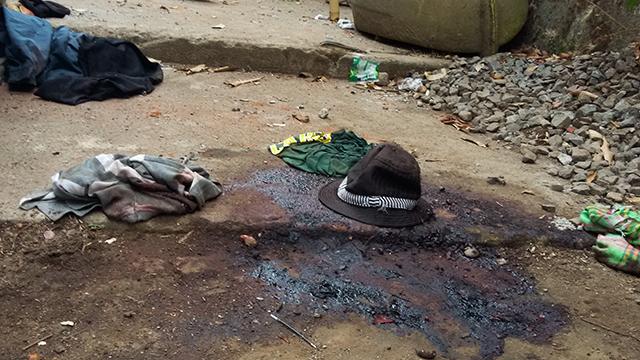
According to the police report, 17-year-old Ernesto Hernández didn’t have a weapon, but he was shot twenty times at close range, in the head, legs, and chest. This March 27, 2015 photo was taken a few hours after his body was taken away the day after the San Blas massacre. Photographer: Nelson Rauda Zablah.
El Faro insists on complicating the moral landscape, and its reporters endure endless criticism as a result. Salvadorans want stories that paint gang members as perpetrators—stories like the crónica Óscar Mártinez wrote from the perspective of a 20-year-old worker forced to traverse San Salvador every morning and evening to avoid crossing the gangs’ “invisible borders”; stories like Carlos Martínez’s investigation of the bus-burning that left 17 passengers dead. Nuanced articles that show gang members as victims, political actors, or human beings routinely provoke fierce backlash. Such articles force people to confront a reality that’s much more complex than they’d like to admit, where blame is diffuse and solutions are scarce. In the words of Amparo Marroquín, a Central American University communications professor: “If you hold a mirror in the face of a monster, it’s going to get furious and smash the mirror.”
“I pray to God I can capture one of those rats employed by that crappy newspaper,” someone wrote on El Faro’s Facebook page under a link to “Police Massacre in San Blas.” “La Sultana’s where to go with the machine guns,” wrote someone else, alluding to the neighborhood where El Faro has its offices. “If you were in Guatemala, your offices would already be burnt down and you’d all be lynched by now,” a third person said.
The week after the story was published, two men on a motorcycle showed up on Óscar Martínez’s street and asked his neighbors to identify his house. Daniel Valencia found his car door open and a stick resembling a police baton in the back seat, along with a calendar with an upcoming date circled. The following week, an informant told editors of an attack planned against Óscar. El Faro traced the threats to at least one person linked to the national police, but 16 months later, no charges have been filed.
El Faro staffers say they are their own harshest critics. Every Monday, they gather to discuss the previous week’s articles, and journalists of different ages and experience toss around feedback. “Journalistic debate in the newsroom makes us grow and protects us from getting too comfortable,” said Carlos Dada in his recent speech accepting the Gabriel García Márquez prize.
But the consequences of outside criticism may ultimately prove more severe. El Faro reporters are “superstars in the global independent digital media community both for the quality of their journalism and the courage of their reporters,” said a leaked internal report from Open Society. “However, it does seem that this international fame and prestige has come at a cost…OSF’s deep and prolonged support has afforded its reporters the luxury of time to spend months working on in-depth stories, in lieu of shorter stories published on a more consistent basis…The long-form, literary journalism that they prefer to practice sets it up to compete well for journalism prizes, but they have not always provided a concise and accessible critique of policies to readers.”
I asked several El Faro journalists if the newspaper had considered doing something more systematic—a database, say, of all homicides committed by police officers, like the one for which The Washington Post won a Pulitzer earlier this year. By collecting as much information as possible and comparing different cases, wouldn’t they be able to show a pattern in what the police were doing, which would create more pressure? Daniel Valencia, who became an editor late last year, demurred. He objected to the idea of “continuous coverage.” “At this point, if the police massacre eight people in a factory, we’re not going to write about it unless it explains something new,” he said.
The long-form, literary journalism that they prefer to practice sets it up to compete well for journalism prizes, but they have not always provided a concise and accessible critique of policies to readers.
But not everyone agrees, and when El Faro has ventured into more systematic coverage, the results have been striking. In October, Roberto Valencia published an in-depth analysis of homicides by police based on statistics obtained through a freedom-of-information request. The data showed a tenfold increase in the number of alleged gang members killed since the government declared war on the gangs: While police killed 39 alleged gang members in all of 2013, 373 have been killed in the first eight months of this year. Valencia consulted Brazilian sociologist and police abuse expert Ignacio Cano, who was alarmed by the ratio of dead police to dead gang members. Anything over one to 10 suggests a possible misuse of force; in El Salvador this ratio is currently one to 53.
Sanz pointed out that El Faro was already stretched thin, but he expressed interest in new kinds of storytelling other than crónica. “So far our model has been to trust the instinct of each journalist for how to tell his story,” he says. “But perhaps we should have a more formal discussion to determine the ideal genre for each.”
That discussion did happen with the San Blas story, and the resulting lede–a marked departure from the rambling intro to the 2012 article on the gang truce–may have been responsible for the story’s impact in El Salvador and internationally. “Police Massacre in San Blas” begins with the following sentence: “Dennis wasn’t even a gang member.” According to Roberto Valencia, this mattered little to the El Faro reporters. “We didn’t investigate this case because he was a civilian,” he says. But their choice to open the story with that sentence acknowledges its weight in the minds of others. “Leading with Dennis was a strategic way of saying to skeptical readers, ‘Keep reading,’” Oscar Martínez says.
Within days, “Police Massacre in San Blas” had sparked follow-up stories in publications across the globe, including Insight Crime, The New Yorker, The Nation, and Vice News. Even El Salvador’s daily newspapers ran stories on the San Blas case—breaking an unspoken rule against citing El Faro—and in the coming months, La Prensa Gráfica and El Diario de Hoy published their own in-depth articles about apparent massacres committed by police. In December, the US State Department included the San Blas case in its annual Human Rights Report.
It’s impossible to know whether the story would have attracted equal attention had all eight victims been gang members. But the fact that Dennis Alexander Martínez was not a gang member had everything to do with what happened on July 8, 2016, almost exactly a year after El Faro published the story. The attorney general’s office arrested six of the police officers involved in the massacre. “Dennis is the window that politically opened the possibility of an investigation,” Martínez says. The six officers are in jail awaiting trial. Three others have fled El Salvador.
The case was thin and built entirely around Dennis’s death. “Attorney General’s Office accuses six police officers for one bullet” was how El Faro chose to describe it. Still, it was unprecedented.
A month later, I stopped by El Faro’s offices and found Óscar Martínez in the newsroom, typing furiously. A local TV channel had just published a video of a gang member’s funeral and claimed (wrongly) that the tattooed body belonged to Dennis. Right-wing politician Guillermo Gallegos had re-tweeted the video with the following caption: “Dennis Martínez, whom police officers killed in self-defense. Judge for yourselves whether or not he was a gangster.”
Martínez whipped off an article. El Faro denounced the false accusation. Then something unexpected happened: Gallegos apologized.
“His apology will make some people in society, against their will and in spite of their hatred, start to change their mental scheme,” Martínez said. I’d never seen him so pleased.
Sarah Esther Maslin is a freelance journalist based in San Salvador and a writer in residence at the Carey Institute for Global Good. She is working on a book about the village of El Mozote three decades after US-trained troops massacred hundreds of civilians in 1981. Follow her on Twitter @sarahmaslin.

